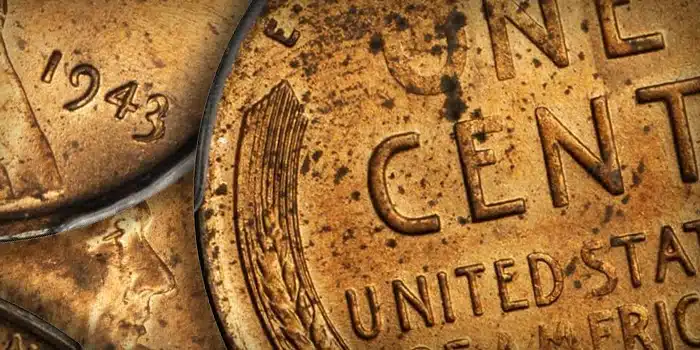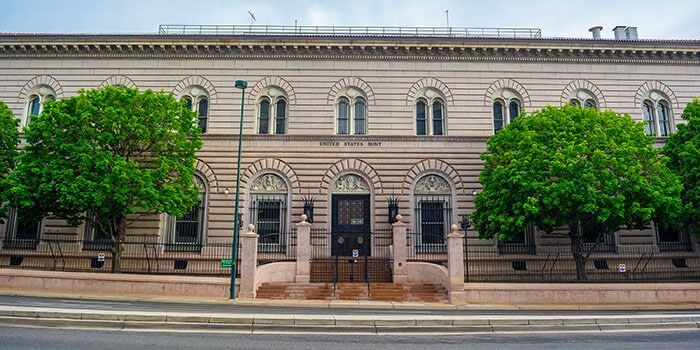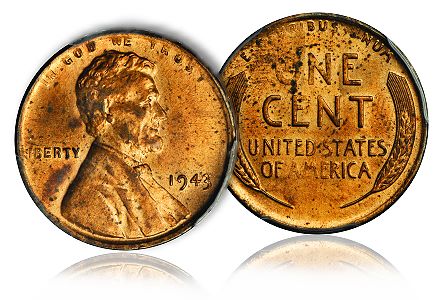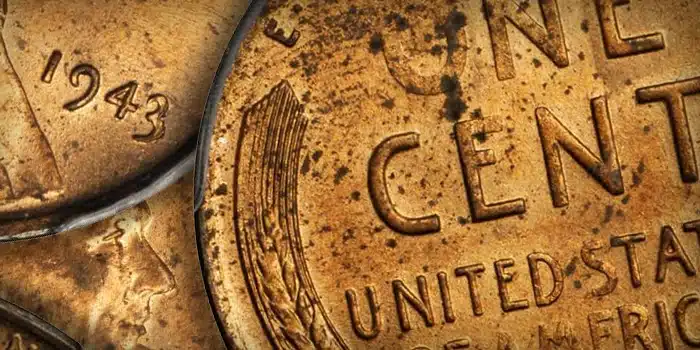
By Charles Morgan and Hubert Walker for CoinWeek Notes …..
1943 Copper Pennies (officially, 1943 Copper Cents) have been found in cafeterias, gum ball machines, and circulating in change. One was even held privately by a Mint Chief Engraver. Another is said to have been spirited out by a Denver Mint employee.
Regardless of how they came upon them or however long the odds that they might be real, readers often write or call us to ask if we will help them authenticate 1943 copper pennies. It’s an understandable request; 1943 copper pennies look like any other copper penny, and the discovery of one can be life-changing for that lucky person.
Let’s take a brief look at the 1943 cent and why ones struck in copper are so rare.
Why Did the Penny Change in 1943?
To the uninitiated, a 1943 copper penny is a popular Mint error wherein the United States Mint struck and released one cent coins that were struck on planchets not intended for cent production that year. What makes this error so captivating is that cents (or pennies) are understood to have been struck in copper during this period, which means that the error is not that the 1943 copper cents look different but that they look the same as any other date – and that was not the Mint’s intent.
Instead, the Mint was ordered to strike coins in an alternative metal, as copper was deemed too strategic for the war effort. The Mint knew as early as 1942 that this change was coming and began to look for an alternative to the copper cent. As a result, experimental coins struck in various non-traditional coinage materials were considered. Some of these made it to the collector market and are desirable in their own right – such as a 1942 glass cent patern.
Ultimately, a composition of zinc-plated steel was selected, and all one cent coins struck in 1943 were supposed to be made using this metal. When a handful of copper planchets were accidentally(?) used to strike 1943 coins, this exciting error coin was the result.
Where Were They Made?

The 1943 cent was struck at three United States Mint locations: Philadelphia, Denver, and San Francisco. Mintmarks (or the lack of them) inform the user of the mint of origin of the coin. On the 1943 copper penny, these mintmarks are easily located. Coins struck at the Philadelphia Mint will not display a mintmark under the date. Coins struck at the Denver and San Francisco mints will be identifiable by the presence of a small mintmark (D for Denver and S for San Francisco) under the date.
The Mint intended for all 1943 cents to be struck in a zinc-plated steel composition. When new, these coins would have appeared silvery-white. Over the course of normal use, this silvery white color turns into a dull slate grey or charcoal.
The total mintage for the issue is as follows:
-
- Philadelphia Mint: 684,628,670 (10 to 15 copper examples are known)
- Denver Mint: 217,660,000 (only one copper example is known)
- San Francisco Mint: 191,550,000 (only five copper examples is known).
How Do I Know if My 1943 Copper Penny Is Genuine?
Attempts to counterfeit 1943 copper pennies began shortly after the release of the 1943 steel cent as rumors of the existence of these off-metal mint errors captured the public’s imagination. In one of these rumors, the Ford Motor Company was said to be offering a new car in exchange for one. In reality, Ford never promised such a trade, but had it done so, in time that deal would have been more beneficial to them than the lucky person that was given the new car in exchange.
Genuine examples did eventually start to turn up, however. The first San Francisco Mint example was discovered in 1944 by collector Kenneth S. Wing, Jr. of Long Beach, California. At the time of his discovery, Wing was offered $500 for the coin. He declined.
For years, Wing tried to get the coin authenticated. Wing wrote to Acting Director of the Mint Leland Howard, who responded on August 20, 1946, “in reference to your letter of August 11th, there were no copper cents struck during the calendar year 1943 at any of the coinage Mints. Only the zinc coated steel cent was struck during that year.” Wing showed the coin to the superintendent of the San Francisco Mint in 1948, and was told that the coin was authentic. In 1957, Wing attempted to have the Treasury Department authenticate the coin. The Treasury Department referred Wing to the Smithsonian Institution. Vladimir Clain-Steanelli was convinced that the coin was authentic.
In 1947, Don Lutes discovered the first one struck at the Philadelphia Mint. He acquired his in change given to him at his Pittsfield, Massachusetts high school cafeteria.

In time, others were discovered. How and by whom is the stuff of auction lot descriptions. While public awareness of these rare copper pennies was widespread, the availability of purchasable examples was not.
To take advantage of this situation, counterfeiters went to work.
Since the 1950s, all manner of manipulations have been undertaken to make common-date copper pennies of the 1940s appear as if they were genuine 1943 off-metal errors. As some of these altered coins can prove to be quite deceptive to a non-expert, third-party authentication is a must.
To authenticate this or any coin, CoinWeek recommends one of three companies: CAC Grading out of Virginia Beach, Virginia; NGC out of Sarasota, Florida; and PCGS out of Santa Ana, California. For a fee, these services will authenticate your coin and, if genuine, place it in a secure, market-acceptable coin holder. This process is a requirement before any coin dealer will agree to purchase the coin or before any major auction service will agree to sell the coin.
To save yourself time, money, and disappointment, a 1943 copper penny must meet the following minimum requirements to be considered genuine:
- 1943 copper pennies are nonmagnetic
- 1943 copper pennies weigh 3.11 grams
- the 3 of the date of 1943 copper penny will be identical to the 3 on a steel cent
- the strike quality of all genuine 1943 copper pennies is sharp, with clear designer’s initials and raised rims. These details can be muted on worn coins, however.
How Does the 1943 Copper Penny Rank in Terms of the Most Valuable U.S. Coins?
While quite rare, the 1943 is not the most valuable United States coin. That honor goes to the nearly impossible-to-own 1933 Saint Gaudens $20 gold double eagle, which last sold for $18.9 million in 2021. For a Lincoln cent, however, the 1943 copper penny is extremely valuable, with circulated examples selling at auction in the past two years bringing between $240,000 and $336,000.
The unique 1943-D copper penny is held in a longterm collection and carries an estimated value of over one million dollars.
The 1943-S cents are rarer than the Philadelphia strikes, and are worth between $300,000 and a million dollars based on their condition.
 Of all of the known 1943 copper pennies, only own survives in Mint State with full original red color. This Choice Uncirculated coin has weak lettering at the top of IN GOD WE TRUST, the first two letters of LIBERTY, and weakness on the reverse in the motto and the O in ONE and AME of AMERICA. Although this example is heavily spotted, it is miraculous that such a rarity survived in close to its original presentation. We estimate it to be worth in excess of one million dollars, as well.
Of all of the known 1943 copper pennies, only own survives in Mint State with full original red color. This Choice Uncirculated coin has weak lettering at the top of IN GOD WE TRUST, the first two letters of LIBERTY, and weakness on the reverse in the motto and the O in ONE and AME of AMERICA. Although this example is heavily spotted, it is miraculous that such a rarity survived in close to its original presentation. We estimate it to be worth in excess of one million dollars, as well.
* * *
Market Data and Noteworthy Specimens
Top Population: PCGS MS63RD (1, 2/2025), NGC MS63BN (1, 2/2025), and CAC MS62BN (2:0 stickered:graded, 2/2025).
- PCGS MS3RD: Stack’s Bowers, January 22, 2013, Lot 13258 – $164,500. Spotted. Struck on 91.7% copper, 7.5% zinc, 08% silver alloy.
- PCGS MS62BN CAC #41955782: Albert Michael Pratt. As NGC MS62BN #2067200-002. Heritage Auctions, August 2017, Lot 3899; Heritage Auctions, April 24, 2021, Lot 5001 – $348,000. Tick over 4 on date.
- PCGS MS62BN CAC #40273606: Marvin Beyer, Jr., discovered in circulation in 1957; Beyer to Greer Company of Los Angeles, 1959 – $40,000. As ANACS MS61 #50035361. Superior, October 2000, Lot 4146 – $60,375. As PCGS MS61BN. “The Benson Collection,” Goldberg Coins, February 2003, Lot 148 – $97,750. As PCGS MS62BN CAC #40273606. “The Bob R. Simpson Collection, Part IV,” Heritage Auctions, February 23, 2021, Lot 3008 – $372,000. Blue green toning.
- PCGS MS61RB #50040291: PCGS user “James Schirrippa”.
- PCGS AU58 #25510132: Heritage Auctions, January 2016, Lot 5266 – $305,500.
- PCGS AU55: Stack’s Bowers, January 22, 2013, Lot 13257 – $317,250.
* * *
Design
Obverse:
Litvak-American artist Victor David Brenner’s portrait of Abraham Lincoln depicts the president from the shoulder up. Lincoln is dressed in a period suit and is wearing a bow tie. Brenner’s initials V.D.B. appear in Lincoln’s shoulder truncation. At the top of the design wrapping around the rim is the motto IN GOD WE TRUST. The word LIBERTY appears behind Lincoln’s neck, on the left side of the coin. The date 1943 appears slightly lower, in front of Lincoln’s portrait, on the coin’s right side.
Reverse:
Brenner’s “Wheat Cent” reverse. Two sheaths of wheat wrap around the right and the left side of the coin. At the top of the design, the motto E · PLURIBUS · UNUM wraps around the rim. The denomination ONE CENT is inscribed in large sans serif letters, with the bottom arm of each “E” extending beyond the arm at the top (the middle arm is recessed). Beneath the denomination, in the same font but a smaller type, is the legend UNITED STATES OF AMERICA.
Edge:
The edge of the 1943 Lincoln Copper Cent is plain, without reeding or edge lettering.
Designer
Victor David Brenner, born in Lithuania in 1871, immigrated to New York at the age of 19. The classically trained sculptor built a group of clients, which included the future president Theodore Roosevelt. Having previously created a medallion of Lincoln, Brenner was contracted by Roosevelt in 1908 to use one of his previous images of the 16th president for a new design of the cent. At the time of his death, Brenner had carved over 125 different medals, sculptures, and coins (View Designer’s Profile).
Coin Specifications
| Country: | United States of America |
| Year of Issue: | 1943 |
| Denomination: | One Cent (USD) |
| Mintmark: | None (Philadelphia) |
| Mintage: | 17 known |
| Alloy: | .950 Copper, .050 Tin and Zinc |
| Weight: | 3.11 g |
| Diameter: | 19.00 mm |
| Edge: | Plain |
| OBV Designer: | Victor David Brenner |
| REV Designer: | Victor David Brenner |
| Quality: | Business Strike |
* * *


